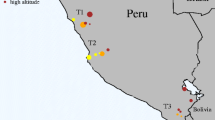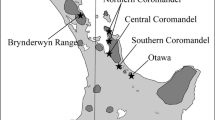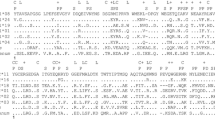Abstract
Immune gene evolution can be critical to species survival in the face of infectious disease. In particular, polymorphism in the genes of the major histocompatibility complex (MHC) helps vertebrates combat novel and diverse pathogens by increasing the number of pathogen-derived proteins that can initiate the host’s acquired immune response. In this study, we used a combination of presumably adaptive and neutral markers to investigate MHC evolution in populations of five salamander species within the Ambystoma velasci complex, a group consisting of 15 recently diverged species, several of which are endangered. We isolated 31 unique MHC class II β alleles from 75 total individuals from five species in this complex. MHC heterozygosity was significantly lower than expected for all five species, and we found no clear relationship between number of MHC alleles and species range, life history, or level of heterozygosity. We inferred a phylogeny representing the evolutionary history of Ambystoma MHC, with which we found signatures of positive selection on the overall gene, putative peptide-binding residues, and allelic lineages. We identified several instances of trans-species polymorphism, a hallmark of balancing selection observed in other groups of closely related species. In contrast, we did not detect comparable allelic diversity or signatures of selection on neutral loci. Additionally, we identified 17 supertypes among the 44 unique Ambystoma alleles, indicating that these sequences may encode functionally distinct MHC variants. We therefore have strong evidence that positive selection is a major evolutionary force driving patterns of MHC polymorphism in this recently radiated species complex.




Similar content being viewed by others
References
Anisimova M, Nielsen R, Yang Z (2003) Effect of recombination on the accuracy of the likelihood method for detecting positive selection at amino acid sites. Genetics 164:1229–1236
Babik W, Pabijan M, Radwan J (2008) Contrasting patterns of variation in MHC loci in the Alpine newt. Mol Ecol 17:2339–2355. doi:10.1111/j.1365-294X.2008.03757.x
Babik W, Pabijan M, Arntzen JW et al (2009) Long-term survival of a urodele amphibian despite depleted major histocompatibility complex variation. Mol Ecol 18:769–781. doi:10.1111/j.1365-294X.2008.04057.x
Baratti M, Dessi-Fulgheri F, Ambrosini R et al (2012) MHC genotype predicts mate choice in the ring-necked pheasant Phasianus colchicus. J Evol Biol 25:1531–1542. doi:10.1111/j.1420-9101.2012.02534.x
Barribeau SM, Villinger J, Waldman B (2008) Major histocompatibility complex based resistance to a common bacterial pathogen of amphibians. PLoS One 3:e2692. doi:10.1371/journal.pone.0002692
Borghans JAM, Beltman JB, De Boer RJ (2004) MHC polymorphism under host-pathogen coevolution. Immunogenetics 55:732–739. doi:10.1007/s00251-003-0630-5
Bos D, DeWoody J (2005) Molecular characterization of major histocompatibility complex class II alleles in wild tiger salamanders (Ambystoma tigrinum). Immunogenetics 57:775–781. doi:10.1007/s00251-005-0038-5
Bos DH, Williams RN, Gopurenko D et al (2009) Condition-dependent mate choice and a reproductive disadvantage for MHC-divergent male tiger salamanders. Mol Ecol 18:3307–3315. doi:10.1111/j.1365-294X.2009.04242.x
Brown J, Jardetzky T, Gorga J et al (1993) 3-Dimensional structure of the human class II histocompatibility antigen HLA-DR1. Nature 364:33–39. doi:10.1038/364033a0
Bulut Z, McCormick C, Bos D, DeWoody J (2008) Polymorphism of alternative splicing of major histocompatibility complex transcripts in wild tiger salamanders. J Mol Evol 67:68–75. doi:10.1007/s00239-008-9125-1
Chen G, Robert J (2011) Antiviral immunity in amphibians. Viruses 3:2065–2086. doi:10.3390/v3112065
Cheng Y, Sanderson C, Jones M, Belov K (2012) Low MHC class II diversity in the Tasmanian devil (Sarcophilus harrisii). Immunogenetics 64:525–533. doi:10.1007/s00251-012-0614-4
Cohen N (1971) Amphibian transplantation reactions: a review. Am Zool 11:193–205. doi:10.1093/icb/11.2.193
Daszak P, Cunningham AA, Hyatt AD (2003) Infectious disease and amphibian population declines. Divers Distrib 9:141–150. doi:10.1046/j.1472-4642.2003.00016.x
Delport W, Poon AFY, Frost SDW, Pond SLK (2010) Datamonkey 2010: a suite of phylogenetic analysis tools for evolutionary biology. Bioinformatics 26:2455–2457. doi:10.1093/bioinformatics/btq429
Devlin B, Risch N (1995) A comparison of linkage disequilibrium measures for fine-scale mapping. Genomics 29:311–322
Doytchinova IA, Flower DR (2005) In silico identification of supertypes for class II MHCs. J Immunol 174:7085–7095
Ellison A, Allainguillaume J, Girdwood S et al (2012) Maintaining functional major histocompatibility complex diversity under inbreeding: the case of a selfing vertebrate. Proc R Soc B-Biol Sci 279:5004–5013. doi:10.1098/rspb.2012.1929
Fisher MC, Garner TWJ, Walker SF (2009) Global emergence of Batrachochytrium dendrobatidis and amphibian chytridiomycosis in space, time, and host. Annu Rev Microbiol 63:291–310. doi:10.1146/annurev.micro.091208.073435
Frank SA (2002) Genetic variability of hosts. http://www.ncbi.nlm.nih.gov/books/NBK2401/. Accessed 3 May 2014
Frost, DR (2014) Amphibian species of the world: an online reference. Version 6.0. American
Goudet J (1995) FSTAT (Version 1.2): a computer program to calculate F-statistics. J Hered 86:485–486
Gray M, Miller D, Hoverman J (2009) Ecology and pathology of amphibian ranaviruses. Dis Aquat Organ 87:243–266. doi:10.3354/dao02138
Hall TA (1999) BioEdit: a user-friendly biological sequence alignment editor and analysis program for Windows 95/98/NT. Nucleic Acids Symp Ser 41:95–98
Hammer O, Harper DAT, Ryan PD (2001) PAST: paleontological statistics software package for education and data analysis. Palaeontol Electron 4:Unpaginated
Hedrick PW, Poulin R (2002) Pathogen resistance and genetic variation at MHC loci. Evolution 56:1902–1908. doi:10.1554/0014-3820(2002)056[1902:PRAGVA]2.0.CO;2
Hill WG, Robertson A (1968) Linkage disequilibrium in finite populations. Theor Appl Genet 38:226–231. doi:10.1007/BF01245622
Holsinger KE, Weir BS (2009) Genetics in geographically structured populations: defining, estimating and interpreting F-ST. Nat Rev Genet 10:639–650. doi:10.1038/nrg2611
Hughes AL, Yeager M (1998) Natural selection at major histocompatibility complex loci of vertebrates. Annu Rev Genet 32:415–435. doi:10.1146/annurev.genet.32.1.415
Huson DH, Bryant D (2006) Application of phylogenetic networks in evolutionary studies. Mol Biol Evol 23:254–267. doi:10.1093/molbev/msj030
Irschick DJ, Shaffer HB (1997) The polytypic species revisited: morphological differentiation among tiger salamanders (Ambystoma tigrinum) (Amphibia: Caudata). Herpetologica 53:30–49
IUCN (2014) The IUCN red list of threatened species. Version 2014.2. http://www.iucnredlist.org. Accessed 21 Oct 2014
Kalinowski ST (2006) HW-QUICKCHECK: an easy-to-use computer program for checking genotypes for agreement with Hardy–Weinberg expectations. Mol Ecol Notes 6:974–979. doi:10.1111/j.1471-8286.2006.01456.x
Kieswetter CM, Schneider CJ (2013) Phylogeography in the northern Andes: complex history and cryptic diversity in a cloud forest frog, Pristimantis w-nigrum (Craugastoridae). Mol Phylogenet Evol 69:417–429. doi:10.1016/j.ympev.2013.08.007
Klein J (1986) Natural history of the major histocompatibility complex. New York
Klein J, Sato A, Nikolaidis N (2007) MHC, TSP, and the origin of species: from immunogenetics to evolutionary genetics. In: Campbell A (ed) Annual review of genetics book series. California Annual Reviews, Palo Alto, pp 281–304
Kobari F, Sato K, Shum B et al (1995) Exon-intron organization of Xenopus MHC class II β chain genes. Immunogenetics 42:376–385
Kurtz J, Kalbe M, Aeschlimann PB et al (2004) Major histocompatibility complex diversity influences parasite resistance and innate immunity in sticklebacks. Proc R Soc B-Biol Sci 271:197–204. doi:10.1098/rspb.2003.2567
Laurens V, Chapusot C, del Rosario OM et al (2001) Axolotl MHC class II β chain: predominance of one allele and alternative splicing of the β1 domain. Eur J Immunol 31:506–515. doi:10.1002/1521-4141(200102)31:2<506::AID-IMMU506>3.0.CO;2-P
Lewontin RC (1964) The interaction of selection and linkage. I. General considerations; heterotic models. Genetics 49:49
Li L, Wang BB, Ge YF, Wan QH (2014) Major histocompatibility complex class II polymorphisms in forest musk deer (Moschus berezovskii) and their probable association with purulent disease. Int J Immunogenet 41:401–412. doi:10.1111/iji.12135
Librado P, Rozas J (2009) DnaSP v5: a software for comprehensive analysis of DNA polymorphism data. Bioinformatics 25:1451–1452. doi:10.1093/bioinformatics/btp187
Martel A, Spitzen-van der Sluijs A, Blooi M et al (2013) Batrachochytrium salamandrivorans sp nov causes lethal chytridiomycosis in amphibians. Proc Natl Acad Sci U S A 110:15325–15329. doi:10.1073/pnas.1307356110
Mattoccia M, Marta S, Romano A, Sbordoni V (2011) Phylogeography of an Italian endemic salamander (genus Salamandrina): glacial refugia, postglacial expansions, and secondary contact. Biol J Linn Soc 104:903–922. doi:10.1111/j.1095-8312.2011.01747.x
McVean G, Awadalla P, Fearnhead P (2002) A coalescent-based method for detecting and estimating recombination from gene sequences. Genetics 160:1231–1241
Moritz C, Schneider C, Wake D (1992) Evolutionary relationships within the Ensatina eschscholtzii complex confirm the ring species interpretation. Syst Biol 41:273–291. doi:10.2307/2992567
Murrell B, Wertheim JO, Moola S et al (2012) Detecting individual sites subject to episodic diversifying selection. Plos Genet. doi:10.1371/journal.pgen.1002764
Murrell B, Moola S, Mabona A et al (2013) FUBAR: a fast, unconstrained Bayesian approximation for inferring selection. Mol Biol Evol. doi:10.1093/molbev/mst030
Nadachowska-Brzyska K, Zieliński P, Radwan J, Babik W (2012) Interspecific hybridization increases MHC class II diversity in two sister species of newts. Mol Ecol 21:887–906. doi:10.1111/j.1365-294X.2011.05347.x
O’Neill EM, Schwartz R, Bullock CT et al (2013) Parallel tagged amplicon sequencing reveals major lineages and phylogenetic structure in the North American tiger salamander (Ambystoma tigrinum) species complex. Mol Ecol 22:111–129. doi:10.1111/mec.12049
Parham P, Janeway CA (2005) The immune system. Garland Science, New York
Parra-Olea G, Zamudio KR, Recuero E et al (2012) Conservation genetics of threatened Mexican axolotls (Ambystoma). Anim Conserv 15:61–72. doi:10.1111/j.1469-1795.2011.00488.x
Pond SLK, Frost SDW (2005a) Not so different after all: a comparison of methods for detecting amino acid sites under selection. Mol Biol Evol 22:1208–1222. doi:10.1093/molbev/msi105
Pond SLK, Frost SDW (2005b) Datamonkey: rapid detection of selective pressure on individual sites of codon alignments. Bioinformatics 21:2531–2533. doi:10.1093/bioinformatics/bti320
Pond SLK, Frost SDW, Muse SV (2005) HyPhy: hypothesis testing using phylogenies. Bioinformatics 21:676–679. doi:10.1093/bioinformatics/bti079
Pond SLK, Murrell B, Fourment M et al (2011) A random effects branch-site model for detecting episodic diversifying selection. Mol Biol Evol 28:3033–3043. doi:10.1093/molbev/msr125
Raymond M, Rousset F (1995) GENEPOP (Version 1.2): population genetics software for exact tests and ecumenicism. J Hered 86:248–249
Richman AD, Herrera G, Reynoso VH et al (2007) Evidence for balancing selection at the DAB locus in the axolotl, Ambystoma mexicanum. Int J Immunogenet 34:475–478. doi:10.1111/j.1744-313X.2007.00721.x
Robert J, Cohen N (2011) The genus Xenopus as a multispecies model for evolutionary and comparative immunobiology of the 21st century. Dev Comp Immunol 35:916–923. doi:10.1016/j.dci.2011.01.014
Ronquist F, Teslenko M, van der Mark P et al (2012) MrBayes 3.2: efficient Bayesian phylogenetic inference and model choice across a large model space. Syst Biol 61:539–542. doi:10.1093/sysbio/sys029
Rousset F (2008) GENEPOP’007: a complete re-implementation of the GENEPOP software for Windows and Linux. Mol Ecol Resour 8:103–106. doi:10.1111/j.1471-8286.2007.01931.x
Sammut B, Du Pasquier L, Ducoroy P et al (1999) Axolotl MHC architecture and polymorphism. Eur J Immunol 29:2897–2907. doi:10.1002/(SICI)1521-4141(199909)29:09<2897::AID-IMMU2897>3.0.CO;2-2
Sandberg M, Eriksson L, Jonsson J et al (1998) New chemical descriptors relevant for the design of biologically active peptides. A multivariate characterization of 87 amino acids. J Med Chem 41:2481–2491. doi:10.1021/jm9700575
Savage AE, Zamudio KR (2011) MHC genotypes associate with resistance to a frog-killing fungus. Proc Natl Acad Sci 108:16705–16710. doi:10.1073/pnas.1106893108
Schad J, Sommer S, Ganzhorn JU (2004) MHC variability of a small lemur in the littoral forest fragments of southeastern Madagascar. Conserv Genet 5:299–309. doi:10.1023/B:COGE.0000031137.50239.d3
Scheffler K, Martin DP, Seoighe C (2006) Robust inference of positive selection from recombining coding sequences. Bioinformatics 22:2493–2499. doi:10.1093/bioinformatics/btl427
Schierup MH, Mikkelsen AM, Hein J (2001) Recombination, balancing selection and phylogenies in MHC and self-incompatibility genes. Genetics 159:1833–1844
Shaffer HB (1993) Phylogenetics of model organisms: the laboratory axolotl, Ambystoma mexicanum. Syst Biol 42:508–522. doi:10.1093/sysbio/42.4.508
Siddle HV, Kreiss A, Eldridge MDB et al (2007) Transmission of a fatal clonal tumor by biting occurs due to depleted MHC diversity in a threatened carnivorous marsupial. Proc Natl Acad Sci U S A 104:16221–16226. doi:10.1073/pnas.0704580104
Skerratt LF, Berger L, Speare R et al (2007) Spread of chytridiomycosis has caused the rapid global decline and extinction of frogs. EcoHealth 4:125–134. doi:10.1007/s10393-007-0093-5
Swofford D (2003) PAUP*. Phylogenetic analysis using parsimony (*and other methods). Version 4. Sinauer, Sunderland, Massachusetts
Teacher AGF, Garner TWJ, Nichols RA (2009) Evidence for directional selection at a novel major histocompatibility class I marker in wild common frogs (Rana temporaria) exposed to a viral pathogen (Ranavirus). PLoS One 4:e4616. doi:10.1371/journal.pone.0004616
Tournefier A, Laurens V, Chapusot C et al (1998) Structure of MHC class I and class II cDNAs and possible immunodeficiency linked to class II expression in the Mexican axolotl. Immunol Rev 166:259–277
Voss SR, Epperlein HH, Tanaka EM (2009) Ambystoma mexicanum, the axolotl: a versatile amphibian model for regeneration, development, and evolution studies. Cold Spring Harb Protoc 2009:pdb.emo128. doi: 10.1101/pdb.emo128
Wegner KM, Kalbe M, Kurtz J et al (2003) Parasite selection for immunogenetic optimality. Science 301:1343. doi:10.1126/science.1088293
Weisrock DW, Shaffer HB, Storz BL et al (2006) Multiple nuclear gene sequences identify phylogenetic species boundaries in the rapidly radiating clade of Mexican ambystomatid salamanders. Mol Ecol 15:2489–2503. doi:10.1111/j.1365-294X.2006.02961.x
Wenink PW, Groen AF, Roelke-Parker ME, Prins HHT (1998) African buffalo maintain high genetic diversity in the major histocompatibility complex in spite of historically known population bottlenecks. Mol Ecol 7:1315–1322. doi:10.1046/j.1365-294x.1998.00463.x
Wilson DJ, McVean G (2006) Estimating diversifying selection and functional constraint in the presence of recombination. Genetics 172:1411–1425. doi:10.1534/genetics.105.044917
Zhu R, Chen Z, Wang J et al (2014) Extensive diversification of MHC in Chinese giant salamanders Andrias davidianus (Anda-MHC) reveals novel splice variants. Dev Comp Immunol 42:311–322. doi:10.1016/j.dci.2013.10.001
Acknowledgments
We thank D. Weisrock for providing A. dumerilii tissue samples for this study, A. E. Savage and D. Rodriguez for the assistance with molecular protocols, R. C. Bell for the assistance with phylogenetic analyses, A. Ellison for supertyping of MHC, and M. Yuan for the assistance with figures. Members of the Zamudio lab group provided invaluable advice and feedback throughout this study. We also thank our two anonymous reviewers for their feedback, which greatly improved the final version of the manuscript. Funding for this study was provided by National Science Foundation Grants (DEB-0815315 and DEB-1120249 to K. R. Zamudio) and an award from the Dextra Undergraduate Research Endowment Fund (to K. E. Tracy).
Conflict of interest
The authors declare that they have no conflict of interest.
Ethical approval
The tissues used for this study were collected by Gabriela Parra-Olea (Parra-Olea et al. 2012). Tissues were collected under the permit FAUT-0106, issued by Secretaria del Medio Ambiente y Recursos Naturales and protocol #1999-0010 issued by the Cornell University Institutional Animal Care and Use Committee.
Author information
Authors and Affiliations
Corresponding author
Rights and permissions
About this article
Cite this article
Tracy, K.E., Kiemnec-Tyburczy, K.M., DeWoody, J.A. et al. Positive selection drives the evolution of a major histocompatibility complex gene in an endangered Mexican salamander species complex. Immunogenetics 67, 323–335 (2015). https://doi.org/10.1007/s00251-015-0835-4
Received:
Accepted:
Published:
Issue Date:
DOI: https://doi.org/10.1007/s00251-015-0835-4




